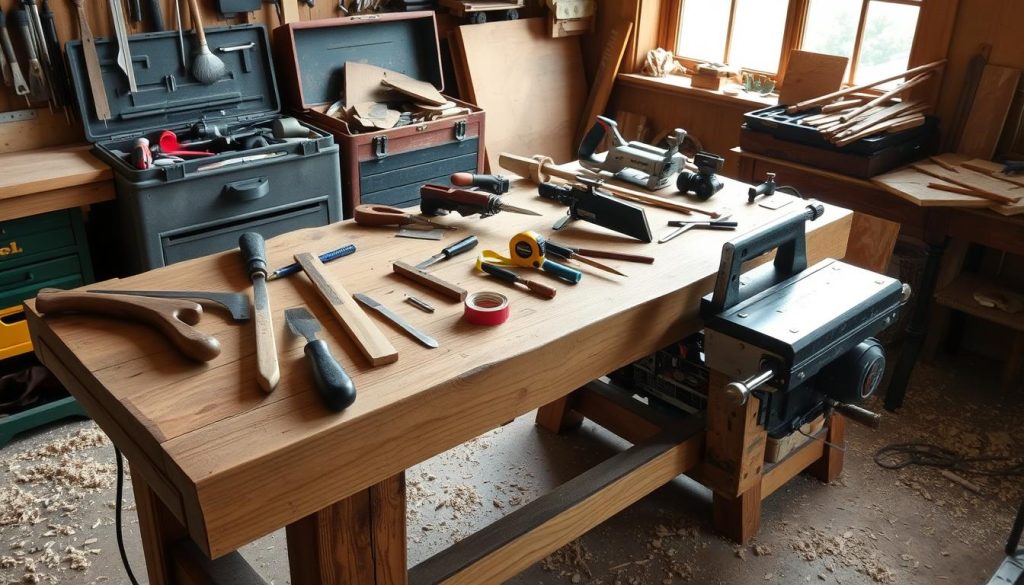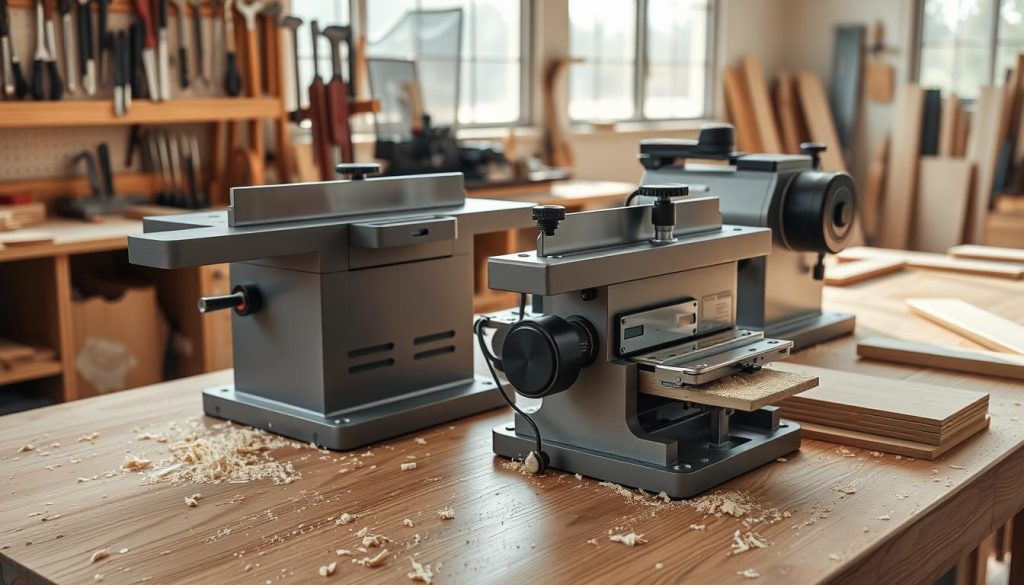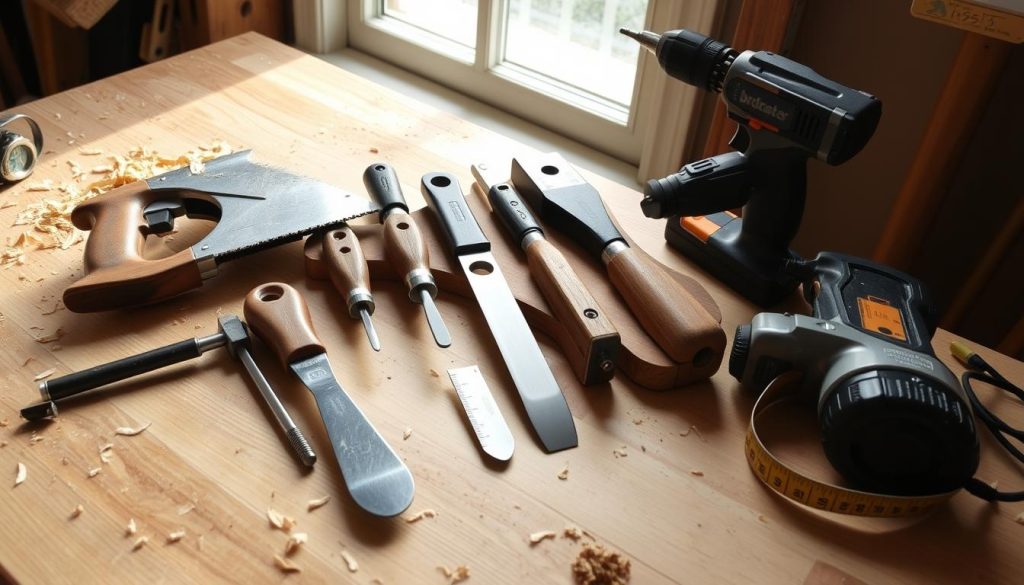Setting up a well-stocked workshop is key for any woodworker, whether you’re new or experienced. The right tools can elevate your projects from simple to professional. This guide will cover the must-have woodworking tools for every DIY workshop. You’ll learn how to tackle various projects with confidence and precision.
At the core of a woodworking workshop are the power tools. These include the table saw, which is crucial for most projects, and the router systems for detailed work. Hand tools, like chisels, planes, and measuring devices, are also vital for fine craftsmanship.
But there’s more to a workshop than just the basic tools. You’ll also need specialty equipment like band saws, jointers, and planers. Plus, safety gear and dust collection systems are essential for quality, efficiency, and safety.
Whether you’re just starting or looking to grow your collection, this guide will help. It’s designed to give you the knowledge to create a workshop that meets your needs and sparks your creativity.

Key Takeaways
- Woodworking tools form the foundation of a well-equipped DIY workshop
- Power tools, such as table saws, routers, and drills, are the workhorses of the shop
- Hand tools, including chisels, planes, and measuring devices, are essential for fine craftsmanship
- Specialty equipment like band saws, jointers, and planers play a crucial role in woodworking projects
- Safety gear and dust collection systems are essential for a safe and efficient workshop
Essential Power Tools for Your Workshop
Power tools are key in woodworking. They range from table saws to router systems. These tools can make your projects better.
Table Saws: The Foundation of Woodworking
The table saw is vital in woodworking. It can rip, crosscut, and make straight edges. SawStop is a top choice for its safety features.
Power Drills and Impact Drivers
A cordless drill driver is essential. Woodworkers look for long battery life and high spin speed. Cordless impact drivers are also popular for their versatility.
Router Systems for Detail Work
Router systems add details and edge profiles. Cordless routers are loved for their portability and versatility. They can make simple designs stand out.
Adding these power tools to your workshop boosts precision and creativity. Always read the instructions to stay safe.
Understanding Woodworking Tools Basics
Learning about woodworking tools is key for DIY fans and hobbyists. Knowing how to use each tool makes your projects better and keeps you safe. When picking tools, think about power, accuracy, and safety.
Start with basic tools for beginners. These include a tape measure, square, saws, chisels, drill, sandpaper, and safety gear. As you get better, you can add more tools.
It’s important to know the basics of woodworking. This includes measuring right, staying safe, and using hand tools well. Learning to saw, join wood, sand, and assemble is crucial. Also, knowing about wood grain and how to glue is important for good projects.
Keeping your workspace safe and efficient is vital. Always wear safety glasses, ear protection, and masks. Using clamps, guides, and jigs can also make your work safer and more accurate.
By learning the basics of woodworking, you can make beautiful projects. These projects will show off your skills and love for woodworking.
- Essential woodworking tools include a tape measure, combination square, circular saw, jigsaw, chisel set, cordless drill/driver, sandpaper, and safety gear such as safety glasses and dust masks.
- Common woodworking safety equipment consists of eye and ear protection and respiratory protection.
- Woodworking often involves a selection between hardwoods like oak, maple, or walnut, and softwoods such as pine or cedar depending on project needs.
- Basic woodworking entails developing skills like measurement and marking accuracy, safety awareness, proficiency with hand tools, and tool maintenance.
- Key woodworking techniques to learn include sawing, joinery methods like butt joints and miter joints, sanding and finishes application, and proper assembly techniques.
- Splintering wood can be reduced by using sharp blades and scoring cuts, while tear-out on cross-grain cuts can be avoided with a low-angle block plane or backer board.
- Tips to prevent warping include selecting well-seasoned wood and proper storage to maintain stability.
- Inaccurate cuts can be minimized by aligning the blade correctly, using cutting guides or jigs, and following cutting techniques accurately.
Must-Have Hand Tools for Beginners
Starting as a woodworker means having the right tools. Power tools help, but hand tools teach the basics of craftsmanship. Here are the key hand tools every beginner needs.
Measuring and Marking Tools
Woodworking needs precision, starting with accurate measurements and marks. You’ll need a good tape measure, combination square, and marking knife. These tools ensure your work is well-planned and precise.
Basic Cutting Tools
For cutting wood, you need hand saws and chisels. A backsaw, like a dovetail saw, makes clean cuts for joinery. A set of bench chisels in different widths is also crucial for tasks like mortises and joint cleaning.
Essential Hand Planes
Hand planes are key in traditional woodworking. A jack plane is great for flattening and smoothing wood. A block plane is perfect for trimming and shaping edges. With practice, these planes will be essential in your workshop.
Starting with these basic hand tools is crucial for your woodworking journey. Remember, quality tools are an investment. You can find great second-hand options to save money.
The Role of Sanders in Wood Finishing
Sanders are key in woodworking and wood finishing. They are vital for both pros and DIY fans. The right sanders can make your projects look smooth and flawless.
The Bosch 5″ orbital sander is perfect for those on a budget. It offers great power and performance. For top-notch results, especially with epoxy, the Festool 150mm (6″) brushless sander is the best choice.
Sanders help get wood ready for staining, painting, or other finishes. They remove imperfections and smooth out rough spots. This makes the surface ready for the finish you want. Sanders are crucial for making furniture, cabinets, staircases, and toys.
There are different sanders like belt, random orbital, disc, and finishing sanders. Each has its own use. Belt sanders are great for removing material and preparing rough surfaces. Random orbital sanders are versatile for polishing and finishing large areas. Disc sanders are good for removing paint and reaching tight spots. Finishing sanders are needed for detailed work that other sanders can’t do.
It’s important to wear protective gear like dust masks and safety glasses when sanding. This keeps you safe while working with these powerful tools. With the right sanders and safety, you can make your woodworking projects look amazing.
Choosing the Right Bandsaw
The bandsaw is a key tool in woodworking, great for cutting curves and slicing thick wood. When picking a bandsaw, think about what you need. Whether you’re new or experienced, here are tips to find the best bandsaw for you.
Bandsaw Features and Capabilities
Bandsaws vary in size, from 14-inch to 20-inch. The size you need depends on your projects. A 14-inch bandsaw is good for small tasks, but for bigger jobs, a 17-inch or 20-inch is better.
Size and Power Considerations
Think about the power and size you need. Grizzly’s 17-inch 2 HP bandsaw is a great value. Laguna, Powermatic, and Rikon also offer quality bandsaws, but they might cost more.
Maintenance Tips
Keeping your bandsaw in good shape is important. Change the blade often, adjust the tension, and check the guides. Using top-notch blades, like Highland Woodworking’s Wood Slicer, makes cuts better. Regular care keeps your bandsaw running smoothly.
Professional-Grade Jointers and Planers
Woodworking needs the right tools to succeed. Jointers and planers are key for every workshop. They help prepare lumber for your projects.
Jointers flatten one face and square one edge of a board. Planers adjust the thickness of pre-milled stock. Many see both as vital for working with rough lumber.
The Jet 6″ jointer is perfect for beginners. It’s reliable and easy to adjust. The 8″ Grizzly parallelogram jointer with a spiral cutterhead offers top-notch results, making work easier.
Jointers are great for specific tasks. But, planers are more versatile. They can be used with jigs for jointing, adding value to your workshop. Planers also let you change the thickness of stock, boosting productivity.
Buying quality woodworking machinery is a big deal. Many woodworkers buy these tools one at a time. But, their benefits make them a worthwhile investment.

Clamps and Vises: Your Third Hand
Clamps and vises are key in woodworking, often called the “third hand.” They hold your workpieces firmly, ensuring accuracy and safety. They are crucial for tasks like large glue-ups and small details. Having the right clamps and vises can greatly improve your work.
Types of Woodworking Clamps
Woodworkers have many clamp options, each for a specific task. Here are some common ones:
- Bar clamps: Great for big glue-ups and joining pieces
- C-clamps: Perfect for attaching to a workbench or holding small parts
- Corner clamps: Essential for perfect 90-degree angles
- Pipe clamps: Ideal for big projects with extra reach
- Trigger clamps: Quick to use for temporary holds
Proper Clamping Techniques
Good clamping techniques are key for even pressure and avoiding damage. Here are some tips:
- Place clamps carefully to avoid warping the workpiece
- Apply even pressure to prevent bending or warping
- Use cauls or padding to protect surfaces from clamp marks
- Tighten clamps slowly to avoid damage
- Try different clamps and vises to find what works best for you
Learning to clamp well will help you complete many woodworking projects with confidence. You’ll get reliable results every time.
Dust Collection Systems and Safety Equipment
Keeping your workshop clean and safe is key for woodworkers. Dust collection systems are vital, from simple vacuums to complex whole-shop setups. They help catch wood dust from power tools, keeping you and your space safe.
It’s also important to have the right safety gear. This includes eye, ear, and respiratory protection. Wood dust can be harmful, causing breathing problems and even cancer.
When picking a dust collection system, think about your workshop size, tools, and dust levels. Cyclone, cartridge, and baghouse collectors are good choices. Clean Air Company can help you find the best fit for your needs.
Don’t overlook the importance of dust collection and safety gear. They protect your health, extend tool life, and make your workspace better. Research well and focus on safety for a healthier future.
- Dust collection systems range from simple shop vacuums to sophisticated whole-shop systems.
- Safety equipment like eye protection, hearing protection, and respirators is crucial to guard against wood dust hazards.
- Consider factors like workshop size, tool types, and dust volume when choosing a dust collection system.
- Work with a trusted supplier like Clean Air Company to design a tailored dust collection solution.
- Prioritize worker safety and invest in effective dust collection and safety gear for a healthier, more productive workshop.
Budget-Friendly Tool Options
Setting up your woodworking workshop doesn’t have to cost a lot. Smart DIYers can find great tools at low prices by looking into budget tools and second-hand gear. You can get everything from power tools to accessories without spending too much.
Second-Hand Tools Worth Buying
Buying used woodworking tools is a smart way to save money. You can find good deals on table saws, bandsaws, and jointers. Make sure to check the tool’s condition, adjustability, and if parts are available before you buy.
New vs Used Tool Considerations
Some tools are better bought new, like power sanders. They wear out quickly, so it’s better to get a new one. Think about warranty, features, and durability when deciding between new and used tools.
Looking into budget tools and second-hand options can help you set up a great workshop without spending a lot. With some research and careful choices, you can find tools that are both affordable and high-quality.

Tool Maintenance and Care
Keeping your woodworking tools in good shape is key. Regular cleaning, lubrication, and sharpening are musts. These steps help your tools last longer and work better. By taking care of your tools, you save time and money.
First, clean your tools well after each use. Use a cloth or soft-bristle brush to remove sawdust and resin. This keeps your power tools from overheating and wearing out too soon. For hand tools, like chisels and planes, sharpen them regularly. This ensures they cut smoothly and accurately.
Don’t forget about lubrication. Apply a thin layer of oil or lubricant to your power tools’ moving parts. This reduces friction and prevents wear. Always check the manufacturer’s advice on the right lubricants to use.
- Regularly clean power tools to prevent overheating and premature failure.
- Sharpen hand tools, like chisels and planes, to maintain their cutting edge.
- Lubricate moving parts of power tools to reduce friction and wear.
- Replace worn parts, such as belts and electrical components, as needed.
- Properly store tools to prevent rust and damage.
By following these easy maintenance tips, your woodworking tools will stay in great condition. This means they’ll work well for many years. A well-maintained tool is a reliable one, and it greatly improves your woodworking projects.
Setting Up Your Workshop Layout
Creating an efficient workshop layout is crucial for better productivity and safety. Think about how your workspace flows. This helps you make the most of your space.
Space Organization Tips
First, measure your workshop’s size and layout. Aim for 125 square feet, with a minimum of 75 square feet. Place tools and workstations to follow a circular path. This keeps your most used items close.
Keep at least 3 feet between machines for safety and ease of movement. Use vertical space for tool storage with pegboards, wall-mounted racks, and mobile carts. This keeps your workshop layout tidy and your workspace organization efficient. Make sure electrical outlets are about 4 feet off the ground for easy access.
Tool Storage Solutions
- Invest in a high-quality tool storage system, such as pegboards or wall-mounted racks, to keep your most-used tools within reach.
- Consider mobile tool carts or cabinets on wheels to transport and store larger power tools, maximizing your workshop layout.
- Use clear, labeled bins or drawers to organize smaller hand tools and hardware, maintaining a tidy and organized workspace.
By focusing on workshop layout and tool storage, you can make a woodworking space that supports your creativity. It helps you work more efficiently.
Advanced Woodworking Tools
For those who love woodworking, advanced tools can make a big difference. These tools let you create detailed designs and precise cuts. They are not needed for beginners but can make a workshop better for experts.
The CNC router is a top tool for advanced woodworkers. It uses digital designs to cut wood accurately. Laser cutters are also key for making intricate designs.
Specialized jigs and fixtures are also important. They help hold wood in place for complex cuts. These tools need time and money but make woodworking better.
Adding advanced tools to your workshop can boost your creativity and work speed. These tools help you achieve more in your woodworking. They make it easier to handle tough projects.
Workshop Safety Essentials
Keeping your workshop safe is key for woodworking fans. Using tools right, wearing the right gear, and keeping it clean are musts. These steps help avoid accidents and injuries. Regular safety checks and learning new safety tips keep your workspace safe.
Protective Equipment
Getting the right protective gear is crucial for safety. Here are some must-haves:
- Safety glasses or goggles to protect your eyes from wood chips and dust
- Masks or respirators to keep harmful particles out of your lungs
- Gloves, either leather or rubber, to protect your hands from cuts and chemicals
- Long sleeves, pants, and closed-toe shoes to cover your skin and prevent injuries
Dust Collection and Ventilation
Good dust collection and ventilation are key for a safe workshop. Use dust collection systems like vacuums or dust collectors to catch wood particles. Make sure there’s enough air flow to prevent dust buildup.
Electrical and Machinery Safety
Follow electrical safety rules by using double-insulated tools and ensuring they’re grounded. Always keep safety guards on power tools. Never use them without guards. Use push sticks and other safety tools to keep your hands safe.
Putting safety first makes your workshop a safe and productive place for woodworking. Remember, safety is always the top priority. The right gear and practices can prevent accidents and injuries.
Conclusion
Building a great woodworking workshop is a journey. Start with the basics and add more tools as you grow. Choose quality over quantity and mix new and used tools for the best value.
Don’t forget about keeping your tools in top shape and staying safe. Good tools make your projects better and make woodworking more enjoyable. With the right tools and skills, you can make amazing woodworking pieces.
Carpentry is all about precision and skill, and you need the right tools. A well-stocked workshop and knowing how to use your tools will make you a skilled woodworker. You’ll be ready for any project that comes your way.